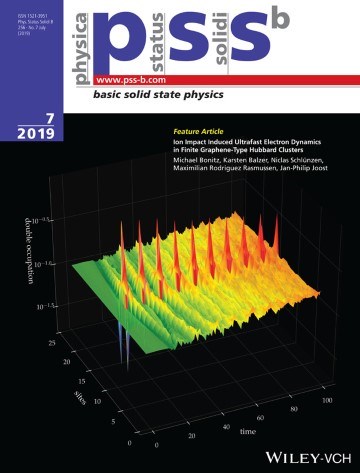Call for Papers
Topical Section in physica status solidi (b)
Progress in Non-equilibrium Green's Functions
Guest Editors: Hugo U. R. Strand, Michael Bonitz, Claudio Verdozzi
Manuscripts due: November 1st, 2023 December 15th, 2023
Submission at: www.editorialmanager.com/pssb-journal
Select Section/Category: Non-equilibrium Green's Functions
Call for papers in pdf-format.
Dear Authors,
Following the remarkable success of the last collection derived from the workshop in 2018, we cordially invite you to contribute again to a high-level Topical Section in ‘pss (b) – basic solid state physics’ that will cover the advances discussed at the meeting ‘Progress in Non-equilibrium Green's Functions 8’ (Örebro, Sweden 7-11 August 2023). The Topical Section will focus on the key open challenges in developing and interfacing the NGF method. Let us encourage you and your collaborators to contribute a Research Article on previously unpublished results, or a Review.
The physica status solidi journals are designed to reach a broad audience in the field of condensed matter and materials physics. pss is one of the largest and well-established publication platforms in solid state physics – now over 60 years in business – and is widely accessible as part of many institutional site licenses, evidenced by close to one million article downloads annually. pss also offers optional Open Access and participates in many funder agreements (more information below).
All submitted manuscripts will undergo peer review. According to the editorial policy of pss, two positive recommendations by independent referees are a prerequisite of acceptance. Peer review and publication occur on individual manuscript basis. Published in Wiley Online Library Early View a few weeks after acceptance, your article is citable immediately; hence there is no waiting for the remainder of the contributions. When all articles are complete, they will be assigned to the next available monthly issue of pss (b).
Please discuss review-type articles with the guest editors prior to compilation. We refer to more information on the next page, and to the author instructions available on our homepage www.pss-b.com → Author Guidelines and the link to online submission through Editorial Manager – please mention the Topical Section in your cover letter and select the appropriate section/category to expedite handling.
From previous experience we are confident that this will become a top publication with excellent international visibility, reflected by high article download and citation numbers.
Looking forward to receiving your contributions!
Sabine Bahrs, on behalf of the Guest Editors
Further information
Please refer to www.pss-journals.com → Author Guidelines.
The physica status solidi (pss) journal group is dedicated to the thorough peer review and the rapid publication of new and important results in all fields of solid state and materials physics, from basic science to applications and devices. physica status solidi (b) - basic solid state physics (pss (b)) has a 2022 Impact Factor of 1.6.
pss are subscription-based journals that also offer authors the option to publish their articles Open Access. Wiley has unique agreements with some funders so you can comply with open access policies. Your funder may also be able to help with open access Article Publication Charges (APCs) through a Wiley Open Access Account. With Wiley Open Access Accounts, APCs may be covered in full or part for affiliated authors. Current agreements include member institutions of KEMÖ, Projekt DEAL, EISZ, CzechELib, CRUI etc. Check pss (b) Open Access and Wiley’s pages on agreements with Funders and Institutions.
Research Articles are unsolicited, peer-reviewed reports of original research results. The essential findings presented in a Research Article should be novel and should not have been published previously. The conclusions must be clearly supported by the data. Whilst a typical Research Article is around 3000–8000 words (in its entirety) including 3–8 display items (figures, schemes, or tables), submitted manuscripts can be any length. However, the scientific contents should justify the length. Manuscripts should include 1) an introduction, summarizing the objectives and main conclusions of the work, 2) the main text of the article, 3) a conclusion, summarizing the conclusions that can be drawn, and optionally 4) an experimental or methods section. In addition, a short abstract (200 words maximum) should be included along with 3–7 keywords. Supporting Information in the form of additional experimental details, display items, movies, etc. may accompany the main article. The main article must stand on its own in the absence of the Supporting Information.
Reviews are peer-reviewed and give an overview of recent progress in important fields of research, providing the readers with a guide to the relevant literature, an appreciation of the significance of the work, and an outlook into potential future directions. It is not intended that Reviews are necessarily comprehensive, but rather insightful, selective, critical, opinionated, and even visionary. The reference list should be well-balanced. Unpublished results should not be included. Whilst a typical Review is 10 000–20 000 words (in its entirety) including 5–15 display items (figures, schemes, or tables), submitted manuscripts can be any length. However, the scientific contents should justify the length and manuscripts should be divided into appropriate sections. In addition, a short abstract (200 words maximum) should be included along with 3–7 keywords.
Related content
Non-Equilibrium Green's Functions


